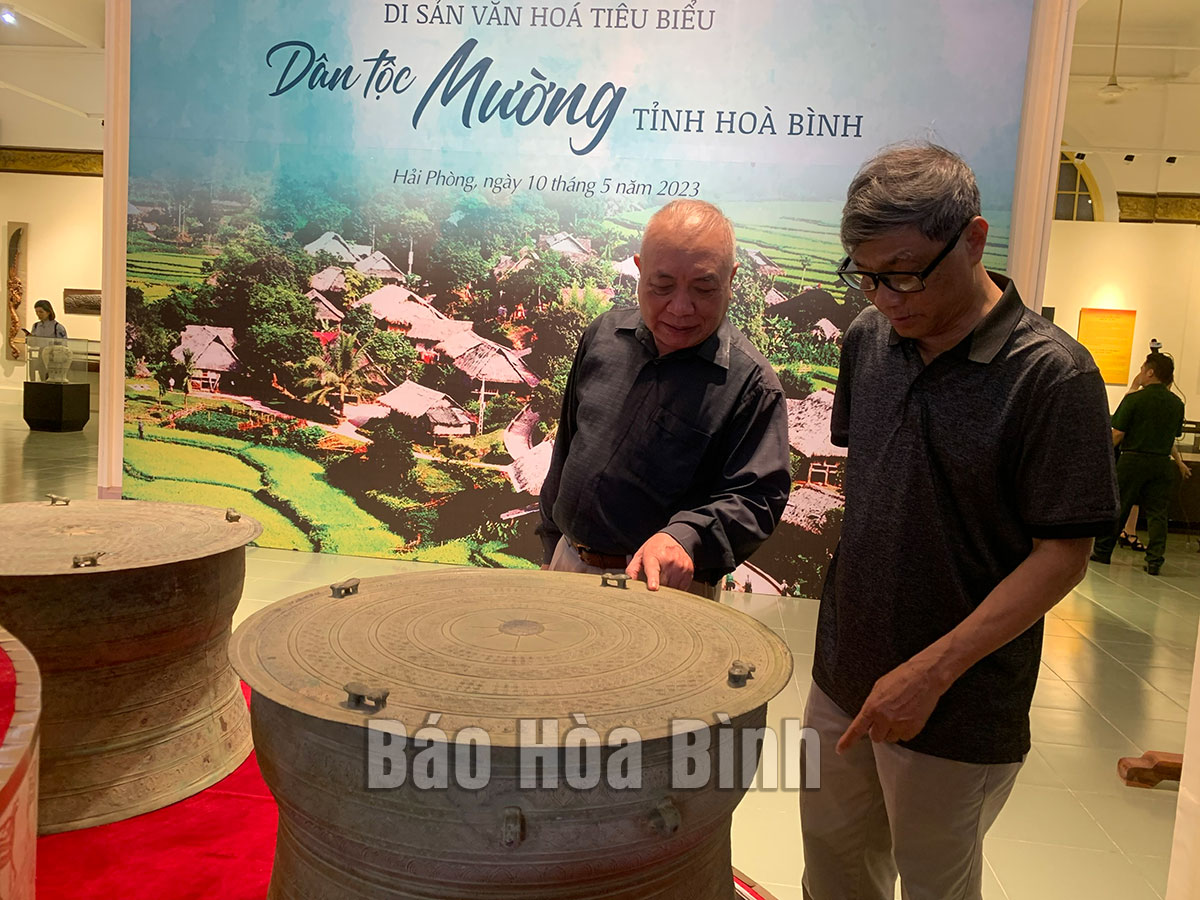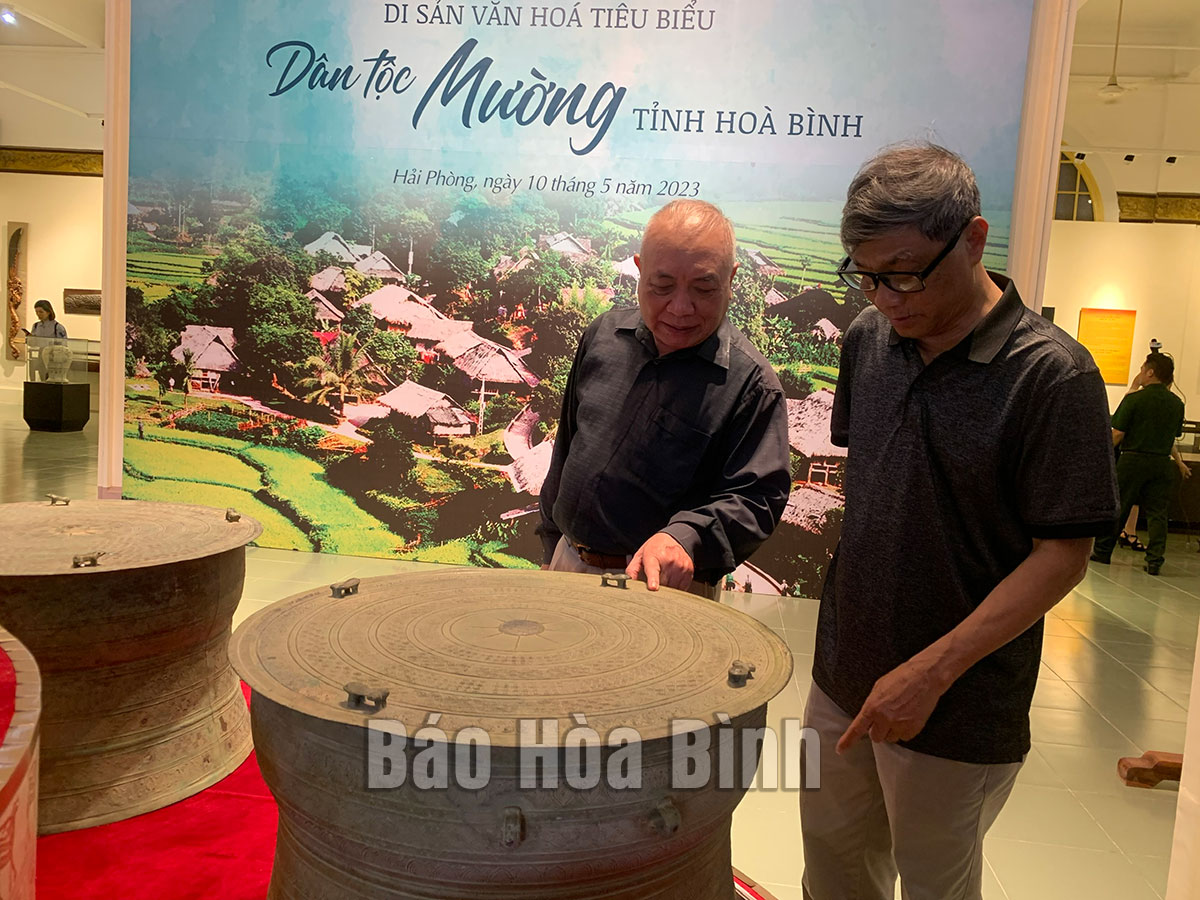
(HBO) – Residents in the northern port city of Hai Phong learnt about cultural heritage and traditional cuisine of the Muong ethnic group in Hoa Binh province through an exhibition held earlier this month at the Hai Phong Museum.
Visitors have a look at a bronze drum displayed at the
Hai Phong Museum.
On display were documents and objects featuring
the Muong group’s cultural heritage. Visitors to the exhibition had a chance to
explore the Muong people’s cultural heritage that has won national recognition
such as the art of playing gongs; Mo Muong - a job and also a performance
practiced at funerals, religious festivals, and life cycle rituals by the Muong
ethnic group; 'Doi' calendar; and Khai ha (going down to the field) festival.
The exhibition also introduced the Muong
people’s spoken and written language, folk literature, social customs,
traditional festivals and performing arts. A range of cultural and art activities
were held on May 10-11.
Nguyen Ba Thanh Long, deputy head of the Hai
Phong antiquities association, said the exhibits present the core of the
national culture, adding that this is the first event that sees the
coordination between the two departments of culture and sports and the Hai
Phong and Hoa Binh Museums.
It helped people understand more about local
culture, while bringing Hoa Binh and Hai Phong closer through culture.
Bui Thi Niem, Director of Hoa Binh's Department
of Culture, Sports and Tourism, highlighted Hoa Binh’s diverse cultural
heritage, which, she said has served as an impulse for the province's
socio-economic development during the cause of reform and integration.
Tran Thi Hoang Mai, Director of Hai Phong city's
Department of Culture and Sports, said the exhibition offered an opportunity to
promote the unique culture of the Muong ethnic group in particular and Vietnam
in general, thus contributing to boosting the tourism sector./.
With an increasingly vibrant and widespread emulation movement aimed at building cultured residential areas and cultured families, Yen Thuy District has been making steady progress toward improving both the material and spiritual well-being of its people, while fostering a civilized, prosperous, beautiful, and progressive community.
Once lacking recreational spaces and community facilities, Residential Group 2 in Quynh Lam Ward (Hoa Binh City) has recently received attention for the construction of a new, spacious, and fully equipped cultural house. The project followed the model of state support combined with public contributions in both labor and funding.
The "All people unite to build cultural life" movement, which has been effectively integrated with Kim Boi district’s socio-economic development goals, is fostering a lively spirit of emulation across local residential areas, hamlets, villages, public agencies, and enterprises. In addition, through the initiative, traditional cultural values are being preserved and promoted, while community solidarity and mutual support in poverty reduction and economic development are being strengthened.
A working delegation of the Hoa Binh provincial People’s Committee led by its Permanent Vice Chairman Nguyen Van Toan on June 11 inspected the progress of a project to build the Mo Muong Cultural Heritage Conservation Space linked to tourism services in Hop Phong commune, Cao Phong district.
Born and growing in the heroic land of Muong Dong, Dinh Thi Kieu Dung, a resident in Bo town of Kim Boi district, in her childhood was nurtured by the sweet lullabies of her grandmother and mother. These melodies deeply imprinted on her soul, becoming an inseparable part of her love for her ethnic group's culture. For over 20 years, this love for her hometown has driven Dung to research, collect, and pass down the cultural values of the Muong people to future generations.
In the final days of May, the Ethnic Art Troupe of Hoa Binh Province organized performances to serve the people in remote, mountainous, and particularly disadvantaged areas within the province. These were not just ordinary artistic shows, but they were the meaningful journeys aimed at spreading cultural values, enhancing the spiritual life of the people and contributing to the preservation of ethnic minority cultural identities.



